How do foods commonly eaten by Southeast Asian communities fit into the four food groups?
How do foods commonly eaten by Southeast Asian communities fit into the four food groups of Canada’s Food Guide?
Vegetables & Fruit
Leafy dark green vegetables
e.g. Pea shoots, Pepper leaves, Water lily greens
Fresh, frozen, cooked or canned
Large-sized
e.g. Banana, Sweet potato
Medium-sized
e.g. Apple, Carrot, Guava, Mango, Orange, Papaya
Small-sized or cut up
e.g. Bamboo shoots, Bean sprouts, Cabbage, Coconut, Durian, Eggplant, Figs, Grapes, Grapefruit, Jackfruit, Jicama, Longan, Lychees, Melons (including bitter melon), Okra, Persimmon, Pineapple, Pomelo, Rambutan, Star fruit, Squash, String beans, Water chestnuts
Roots
e.g. Cassava, Leeks, Taro root, White radish, Yam
Grain Products
Breads
Bread e.g. French, White Ensaymada (very sweet bread from the Philippines) Pan de sal (bread from the Philippines) Rice bread
Cereals
e.g. Oatmeal
Grains
e.g. Rice (jasmine, sticky rice)
Flour
e.g. Rice flour, Tapioca
Noodles
Mung bean noodles
Rice noodles, Rice sticks
Rice wrappers
Wheat noodles
Milk & Alternatives
Milk
e.g. Fluid, Evaporated
Cheese
Leche flan (milk pudding from the Philippines)
Halo halo (milk drink with fruit and beans)
Meat & Alternatives
Dried beans
e.g. Chickpeas, Mung beans, Soybeans, White beans
Dried peas
e.g. Black eyed peas
Fish—fresh or dried
Seafood
e.g. Crab, Shrimp
Tofu
Poultry
e.g. Chicken, Duck
Meat
e.g. Beef, Goat, Lamb, Pork
Organ meats
e.g. Kidney, Liver
